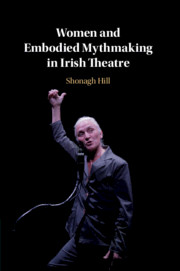Book contents
- Women and Embodied Mythmaking in Irish Theatre
- Women and Embodied Mythmaking in Irish Theatre
- Copyright page
- Dedication
- Contents
- Acknowledgements
- Introduction: A Creative Female Corporeality
- Chapter 1 Revolutionary Bodies: Mythmaking and Irish Feminisms
- Chapter 2 Unhomely Bodies: Transforming Space
- Chapter 3 Metamorphic ‘Bodies That Matter’: Process and Resistance
- Chapter 4 Staging Female Death: Sacrificial and Dying Bodies
- Chapter 5 Haunted Bodies and Violent Pasts
- Chapter 6 Olwen Fouéré’s Corpus: The Performer’s Body and Her Body of Work
- Bibliography
- Index
Chapter 4 - Staging Female Death: Sacrificial and Dying Bodies
Published online by Cambridge University Press: 29 August 2019
- Women and Embodied Mythmaking in Irish Theatre
- Women and Embodied Mythmaking in Irish Theatre
- Copyright page
- Dedication
- Contents
- Acknowledgements
- Introduction: A Creative Female Corporeality
- Chapter 1 Revolutionary Bodies: Mythmaking and Irish Feminisms
- Chapter 2 Unhomely Bodies: Transforming Space
- Chapter 3 Metamorphic ‘Bodies That Matter’: Process and Resistance
- Chapter 4 Staging Female Death: Sacrificial and Dying Bodies
- Chapter 5 Haunted Bodies and Violent Pasts
- Chapter 6 Olwen Fouéré’s Corpus: The Performer’s Body and Her Body of Work
- Bibliography
- Index
Summary
The threat of death and femininity converges on the dead female body which is stabilized and symbolized through limiting myths of femininity that augment women’s unhomely sense of a lack of accommodation within the cultural imaginary. In order to examine the possibilities for resisting the enforcement of silence on women’s bodies and their experiences by tropes of death and femininity, this chapter explores staging the ritual of sacrifice in Marina Carr’s Ariel (2002) and Edna O’Brien’s Iphigenia (2003), and probes the performance of the ‘good death’ in Carr’s Woman and Scarecrow (2006). How might the beautiful feminine corpse be reappropriated in order to destabilize woman’s petrification as a monument to death and silence onstage? This chapter focuses on how the three plays render the uncanny and unhomely visible and disruptive in performance. Moreover, these myths of death and femininity still have currency and offer recognizable cultural forms; discussion of Ariel, Iphigenia and Woman and Scarecrow addresses the potency of these myths within Celtic Tiger Ireland, and within the context of postfeminist and neoliberal frameworks.
- Type
- Chapter
- Information
- Women and Embodied Mythmaking in Irish Theatre , pp. 135 - 171Publisher: Cambridge University PressPrint publication year: 2019

